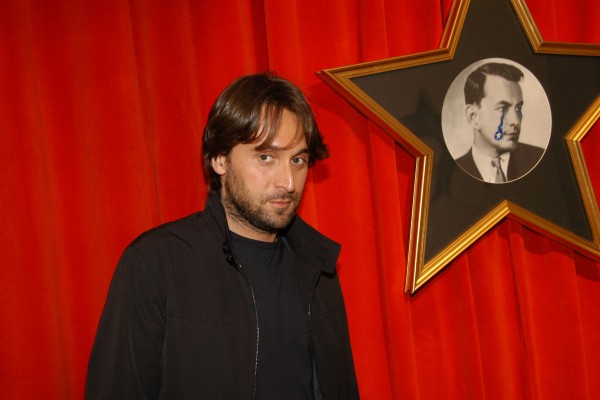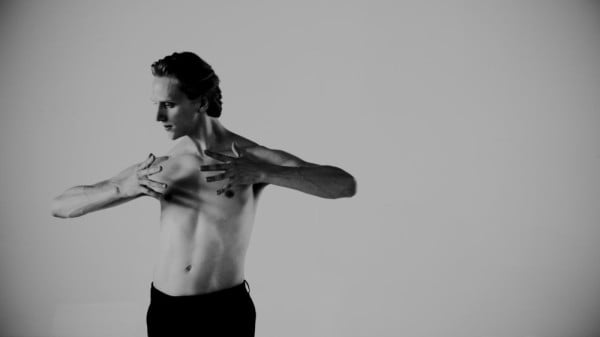Art & Exhibitions
Will Francesco Vezzoli Win Back the Art World With His New Performa Production?
No celebrities were harmed.

No celebrities were harmed.

Cait Munro


Francesco Vezzoli and David Hallberg, Fortuna Desperata (2015)
Photo: Francesco Vezzoli, courtesy of L’Uomo Vogue, Conde Nast Italia
If he’s known for anything, artist Francesco Vezzoli is known for his lush and ostentatiously star-studded works. For his 2005 short Trailer for a Remake of Gore Vidal’s ‘Caligula’, a faux-trailer for a redo of the 1979 erotic drama Caligula, he enlisted Milla Jovovich, Courtney Love, and Gore Vidal. For his 2011 show at Gagosian, in which the gallery was reconstructed to look like a Renaissance Chapel, Vezzoli had pictures of supermodels as crying saints. And for his 2007 performance at Performa, he had the iconic actress Anita Ekberg—of La Dolce Vita fame—on stage, while droves of celebrities battled to get into the space just to see it.
But for Fortuna Desperata, a piece created with Bolshoi Ballet principal dancer David Hallberg for the Performa Biennial, Vezzoli is doing something a little different. He is not using one single celebrity.
“I love it,” said Vezzoli about his recent foray into contemporary dance. We were sitting in the lobby of the stately, Romanesque Mercer Hotel in Soho, where the Milan-based artist stays whenever he’s in New York. A group of his fashionable friends in leather jackets and hoodies scattered when we arrived. “It’s just the opposite of some silly people splashing color on a canvas.”
While he’s a very successful artist by just about anyone’s standards (he’s represented by Gagosian, has had solo shows at MoMA PS1 and Milan’s Fondazione Prada, and has been included in the Venice, Istanbul, and Whitney biennials), it’s easy to take his snarky statement about painters as a provocation—as if he’s getting back at the art world that has at times mercilessly criticized his work.
For his 2011 show at Gagosian, Jerry Saltz called it “stunningly shallow” and “empty-hedeadly decadent.” With respect to Trailer for a Remake of Gore Vidal’s ‘Caligula,’ Linda Yablonsky wrote that many viewers of the film found Vezzoli to be “a celebrity-worshipping pretender whose trailer was a little too much like the real thing to qualify as art.” And for his 2007 Performa commission, he was criticized for stranding David Byrne, Cindy Sherman, and Salman Rushdie among other VIPs outside the Guggenheim in the cold for over an hour during the heavily delayed opening. Vezzoli later explained that the holdup was due to problems inserting Ekberg’s sky-scraping blonde hair pieces.
Yet, some have argued that the excess in his work is precisely the artist’s point. Christopher Knight called Vezzoli’s LA MOCA retrospective a “welcome respite from the humdrum tragedy of modern life.” Then there are the inevitable comparisons to Pop artist Andy Warhol known for creating his own flock of quasi-celebrity “superstars.” Dominc Eichler said, “Vezzoli, like Warhol, gets deep, by investigating the allusiveness of surface and the abstractness of personality.”
Is Vezzoli, who is humble and charming in person, trying to win his critics over and show them once and for all that his work holds up without the aid of celebrity fire-power? If so, he certainly denies giving any power to his critics.

Francesco Vezzoli
Photo: Stefanie Keenan/Patrick McMullan.
“I don’t see why I should be worried,” said Vezzoli flashing a quick smile. “Some people may not like it. My brain thinks like I am curating, say, a Fra Angelico exhibition at a new museum. Some people will go and say, ‘Oh, we like Fra Angelico.’ Some people will see it and will not read that. But I’m still doing something that has meaning,” he said and then paused in thought. “Some other times, I was more worried, but this time…,” he said and let his sentence trail off and then smiled and shrugged his shoulders.
“I don’t think it has anything to do with me, and it probably has nothing even to do with the person I’m convincing, in a sense,” he said when asked how he manages to wrangle such high-profile people to work with him. “People feel that when I propose something to them, it has meaning. I’m relating to them that they are the only one out there who could do this.”
In this case, the “only body and brain that could be inflated with the spirit of the 15th century” was Hallberg.
Perhaps it’s easier for Vezzoli to adopt a devil-may-care attitude with Fortuna Desperata in particular because it’s more rooted in historical fact than personal expression. The 30-minute performance recreates a 15th century style of dance enacted not as a spectacle for hundreds of people, but as a physical exchange between noblemen and the members of their court.
Choreographer Dede Colonna has reconstructed three routines by three Renaissance dance masters that were created with the lofty goal of using dance as a means to transcend human nature and produce a shared experience rather than to serve as mere entertainment. Vezzoli and Hallberg have stayed true to this purpose in the performance, keeping the steps of the dance exactly as they were in the 15th century courts.

Francesco Vezzoli and David Hallberg.
Photo: L’uomo vogue.
Vezzoli’s initial encounter with Hallberg happened in the style of most great art world meetings: across the table at a private dinner. The creative chemistry between the pair was—and is, upon meeting them—both heady and immediately apparent.
“What’s really fascinating about this collaboration is that Francesco has his audience and his critics [and] I have my audience and my critics,” said Hallberg, a tall, striking blonde with chiseled features and a deliberate gaze who was seated next to Vezzoli and Colonna at our table. “And a lot of them don’t know of each other. So his world thinks I am just this dancer…and maybe a waiter on the side,” he said and laughed. “And I’m here to say, this is who I am. And then I’m here to bring the dance audience in and say ‘this is who he is.'”
Indeed, Fortuna Desperata is an unexpected pivot for Vezzoli away from the blinding flash of Hollywood and towards the relatively cloistered world of contemporary ballet, a disciplined and highly traditional arena that provides a striking counterpoint to the laissez-faire attitude of the art scene. It’s obviously not the first time he’s produced work devoid of overtly pop themes, but it’s surprising to see him do it in a forum as major as the opening night of Performa.

David Hallberg.
Photo: Pierce Jackson/Performa.
“Francesco has a real interest in getting closer to these human fascinations,” said Astrid Welter, head of programming at the Fondazione Prada, who has worked with Vezzoli on several occasions, in a telephone interview. “His has been a constant attraction that in a way serves as a metaphor for our own attraction to celebrity. He shows us mirrors of our own voyeurism.”
But Fortuna Desperata also differs from many of Vezzoli’s prior works in that its aim is to be more of a portal to a different time than a window to a different world, albeit one with a hint of modernity.
“I didn’t want to do some dusty reconstruction,” said Hallberg noting that they’re bringing the work up to date with the lighting, set design, and costumes (which are designed by Miuccia Prada). “Our egos aren’t speaking in [a way in which] we are deciding to change any of the steps that were written and that were documented so meticulously. I think that would be highly presumptuous.”
Sticking to the precise choreography of the earlier dances gives Vezzoli another purported out with his critics. “If somebody will come and say, ‘Oh we didn’t like that dance,’ I would say, ‘Well, that’s the way it was,'” Vezzoli said in a matter-of-fact way. “We’re not here for you to review whether or not these people from the 15th century did a good job as choreographers. We are here opening it up for you to see.”
His final request for viewers of this new work is simple: “Just stop for a moment and allow yourself half an hour of this simple pleasure.”